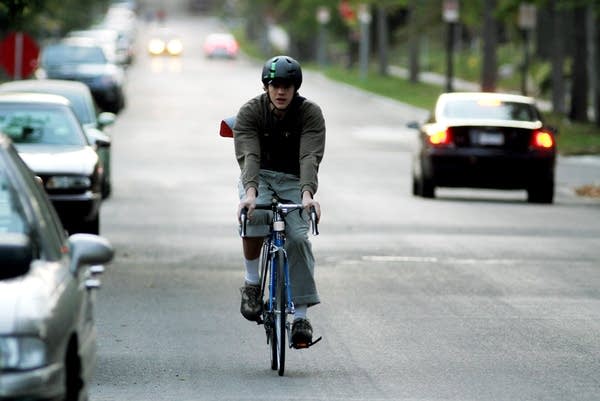Bicycle safety: Minnesota's efforts held up as model for US

When U.S. Transportation Secretary Ray LaHood picked Minnesota to host one of two bicycle safety summits, he held the state up as a model of how a place can increase the number of bikes on the road without increasing deaths.
The number of bicycle fatalities in Minnesota declined in each year from 2008-2011. But nationally, bike fatalities increased 9 percent from 2010-2011, according to the National Highway Traffic Safety Administration. Bicycle deaths also accounted for a growing number of overall traffic deaths — 2.1 percent in 2011, NHTSA said.
But transportation planners acknowledge there's still work to be done in Minnesota to improve bicycle safety.
Preliminary data from the Minnesota Department of Public Safety show a slight uptick in bicycle deaths in 2012 — seven were killed, compared to five in 2011. Injuries were down by about 6 percent in 2012.
Create a More Connected Minnesota
MPR News is your trusted resource for the news you need. With your support, MPR News brings accessible, courageous journalism and authentic conversation to everyone - free of paywalls and barriers. Your gift makes a difference.
The bike safety summit will include state and local transportation planners, advocacy groups and others.
In Minneapolis, transportation officials are working to reduce the number of bike crashes, even though the crash rate — the number of crashes as compared to the overall number of bicyclists on the road — is declining.
LaHood said bike deaths should not automatically increase as the number of bikes increases.
"That's a cynical position that I do not accept, and that the men and women in NHTSA and the Federal Highway Administration who work hard every day to improve road safety do not accept," LaHood wrote this week in his blog.
Minneapolis officials cite the declining crash rate is a reason to be hopeful. The number of regular bicycle commuters in the city doubled over the past two decades, while the number of reported crashes has held relatively steady, the city reported in January. The number of bikes on Minneapolis streets has increased by 50 percent in just the last six years.
The event in Minneapolis includes panel discussions by engineers and city planners, a bike safety expo and a ride around some of the city's bike friendly streets. Several of the speakers will talk about some of steps taken in Minnesota to improve bike safety.
Joan Pasiuk, director of the Bike Walk Twin Cities program, said one way Minneapolis has worked to improve safety is by establishing bike boulevards. The low-speed streets discourage motor vehicle traffic while giving bicycles the option to travel in the middle of the street.
The boulevards "give bicycles and cars a different way to interact," said Pasiuk, whose group is helping organize the summit.
Detailed bicycle safety data for Minnesota isn't available yet, but the 2011 data show that failure to yield was the reason most often cited for bicycle crashes. In about 40 percent of the crashes, a motorist's failure to yield was cited, where as a bicyclist's failure to yield was listed in 30 percent of the crashes.
Below is a list of other bicycle crash facts from the Department of Public Safety's annual report.
• Bicycle crashes happen during warm weather (about 80 percent of crashes involving injuries occurred April-September)
• A third of weekday bicycle crashes occurred during the afternoon rush hour
• About 60 percent of bicycle crashes happened in cities with populations larger than 50,000
• About 65 percent of the bicyclists injured in crashes in 2011 were age 24 or younger
• Males were nearly three times more likely to be injured in a bike crash than females
• At least 40 percent of bicycle crashes happened when the bicyclist was riding with traffic
